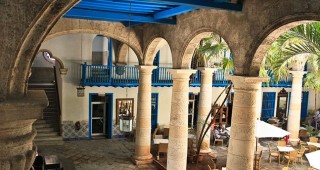
This museum opened in 1964 and is housed in the house of José Gómez Mena, a mansion designed by the French architects P. Virad and M. Destugué in 1927. Gómez’s sister, María Luisa Gómez Mena, a wealthy patron of Cuban artists, was a vital figure in the Havana of her time. At the sumptuous residence she hosted parties and gatherings which were attended by celebrities from Cuba and other parts of the world, from aristocrats to movie stars, to intellectuals, to politicians.
Since July 24, 1964, it has been home to the National Museum of Decorative Arts. Aristocratic wealth, taste and passion are revealed through the more than 33,000 works of artistic and historic value from the reigns of Louis XV, Louis XVI and Napoleon III, as well as Oriental pieces from the 16th to the 20th centuries. Also on display are important collections of Sèvres, Chantilly, Limoges, Faenza, Meissen Derby, Chelsea, Wedgwood, Worcester and Staffordshire porcelain.
The furniture held in the museum is also part of the exhibit and includes the outstanding 19th-century polychrome Venetian guéridon or pedestal table, inlaid with Italian marble; a chest of drawers made for the Sceaux Chateau and other pieces of furniture in the Main Hall that show the evolution of Regency, Rococo and Transition styles; the Regency-style dining room, with walls covered in Italian marble and floors with beautifully designed French rugs; and a clock with bronzes by Cafieri (son) and machinery by Martinot, Louis XV’s clockmaker; and the Neoclassical Room with Louis XVI furniture, two mercurated bronze candlesticks, made by Clodion, which rest on two neoclassical consoles with Italian marble tops.
The mansion is surrounded by gardens that complement the interiors. Four Italian marble sculptures made in the 19th century, representing spring, summer, autumn and winter enhance the El Jardín de Las Estaciones, or The Garden of the Seasons, to the east of the house. El Jardín de Noche, or The Night Garden, to the west, is decorated with rococo and neoclassical inspired sculptures.
This beautiful museum, equipped with one of the most attractive staircases to be found in Cuban residential architecture, has interior decoration by Jansen of Paris and French mahogany carpentry. The first floor has rococo Louis XV period furniture, tapestries, paintings, a Regency-style dining room with walls covered in Italian marble, and paintings by Hubert Robert, among others. The second floor has collections of Chantilly, Meissen, Sevres, Wedgwood and Faenza ceramics, Oriental porcelains, and Chinese crystal and decorative folding panels.














 Colonial
Colonial





